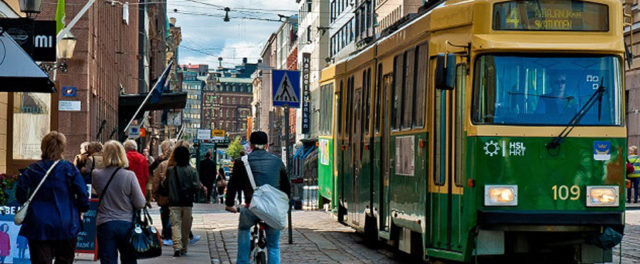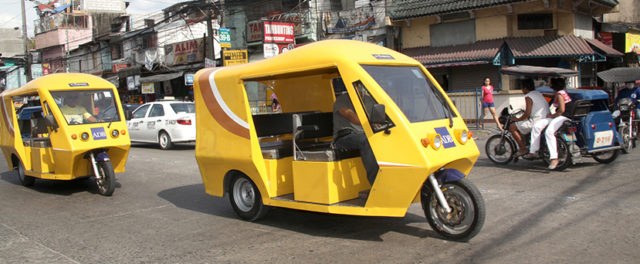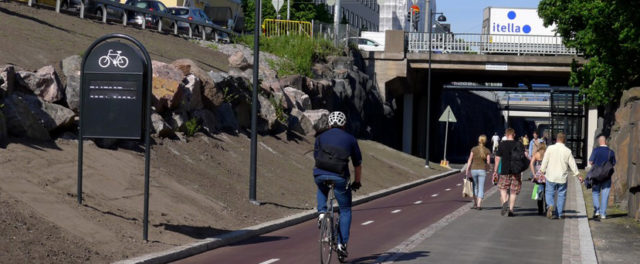Connected Urban Mobility: Q&A with NCF Senior Fellow Greg Lindsay
September 1, 2015 — Blog
As one million people move to cities each week, urban transport systems are being tested more than ever before. Meanwhile, technological innovations, depleted energy supplies, economical shifts, lifestyle changes and the evolution of urban design are all affecting urban mobility needs. How can cities find and implement new solutions to the mobility challenge? How could cities better utilize technology to transform outmoded systems? How could they share solutions to common problems?

In June 2015, we launched the Connected Mobility Initiative with support from the Toyota Mobility Foundation to address the critical need for metropolises worldwide to find viable mobility solutions. The Initiative will produce a case-based report in spring 2016. Our Senior Fellow, Greg Lindsay, is leading the research. We sat down with him to find out more.
NCF: The Connected Mobility Initiative will analyze the evolution of “mobility-as-a-service”. Can you explain what this means, and which bodies are fuelling this evolution?
GL: The phrase has a double meaning. In one sense, it refers to whatever comes after the privately owned and operated automobile or motorcycle, or other forms of personal automotive transport. This has been the dominant mode of transportation in developed nations for literally a century — 1915 was the year the millionth Model T rolled off Henry Ford’s assembly line — and that’s changing. “Mobility-as-a-service,” “mobility-on-demand,” and “shared mobility,” all refer to a new paradigm where the ease, cost, and convenience of personal transport is no longer contained within a depreciating physical asset, but has become a service — typically one you summon with the touch of a button on your smartphone. And that brings us to the second meaning of “mobility-as-a-service,” which is a riff on software-as-a-service, the Silicon Valley business model in which software (and by now the rest of computing) is delivered via pay-as-you-go pricing from large-scale infrastructure in the cloud. Think Amazon Web Services or Salesforce.com. Or Uber.
It’s pretty clear that Uber and its competitors — Lyft, Didi Kuaidi, GrabTaxi, and Ola, just to name a few — are the first large-scale realization of mobility-as-a-service, but they won’t be the last. We have yet to see large-scale peer-to-peer car-sharing, for example, not to mention autonomous cars. Somewhere beyond that is the ultimate near-term prize: a service combining every mode of transit in the city, public and private, in a single app with a single map and fare payment system. What steps will it take to get there? How will we knit personal transport with private services? And who’s going to own it? That’s what I want to know.

NCF: Our Initiative will look at different case studies from cities across the world: Washington D.C., London, São Paulo and Manila. Why were these cities chosen?
GL: Each city embodies a trend or an issue I believe is worth exploring. Washington D.C. is the first or second city in which many of these new private services have launched, first car-sharing services like Zipcar and Relay Rides, then hailing apps like Uber and Lyft, and now a new generation of services such as the pop-up bus routes of Bridj, the shared rides of Split, and mapping apps like Ride Scout. Together with real-time delivery services, they’ve already changed development patterns within the District and metro area in significant ways. London is just one of many European cities exploring how the public sector might take the lead in mobility innovation. There is also Tallinn’s free public transit, Helsinki’s ambitious attempt at a total mobility-as-a-service system, and Germany’s pioneering “mobil.punkts” in Bremen twenty years ago that were the first bus stations to combine bike- and car-sharing.
Metro Manila may have the world’s largest informal transit system, with “jeepneys” and “trikes” plugging the many gaps in the megacity’s transit network, and extending coverage to the city’s informal settlements. What happens when these informal modes are made visible through technology? On the other hand, Sao Paulo is where I hope to explore issues of equity. The protests still roiling Brazil began two years ago in Sao Paulo with the equivalent of a US$0.19 increase in transit fares, which was enough to send millions into the streets. Given the importance of transportation to social mobility, how can mobility-as-a-service play a role in guaranteeing our “right to the city”?
NCF: How could city governments become better equipped to take the lead in shaping innovative mobility solutions? How will the Connected Mobility Initiative support them?
GL: Until now, Uber and its competitors have dictated the terms to cities: “You’re either with us or against us. Either let us rewrite regulations as we see fit, or suffer the consequences.” It has been remarkably effective, but there’s no reason it has to be this way, not when cities operate public transit, regulate private operators, and are responsible for guaranteeing, maintaining, and strengthening mobility as a public good. As a first step, public officials need to drop the assumption that they can never lead or innovate. American city officials believe this, anyway, although it’s less true in Europe. But I’m heartened to see, for example, that Los Angeles Mayor Eric Garcetti is hiring a mobility czar to advise him.
Two areas I hope to explore are the emerging partnerships between cities, and the “transportation network companies” struggling to carve out a defensible niche against Uber. I’ve heard, for example, that Lyft has approached northern California’s public transit agencies about working more closely together, given the fact that a significant percentage of trips on the peninsula are to and from Caltrain stations. Another startup named Via — which offers seats aboard shared vehicles in New York — is exploring the possibility to license its software to transit agencies. These kinds of partnerships will hopefully become common. I also hope to discover more than a few best practices, along with the institutions capable of disseminating them. WRI Sustainable Cities, for example, has been hugely influential in propelling the spread of bus rapid transit and the adoption of cleaner fuels. I hope we’ll see something similar arise for mobility-as-a-service.

NCF: The City of Helsinki offers a forward-thinking model of multi-modal transport management. Could you tell us more? Is this a model that other cities could easily follow?
GL: Last year, the Finnish capital announced a plan for a seamless mobility-as-a-service that would work so well as to make auto ownership redundant by 2025. The idea is to create an app similar to the one I described earlier — one that could draw on data from different modes to offer you multiple journeys from A to B, along with how much each costs and a one-click payment method for any of them — that would sit atop new “mobility providers,” which would in turn offer packages drawn from a mix of participating public and private services. The plan has a certain logic to it — by allowing customers to purchase mobility through third parties competing on price, service, and new features, you theoretically avoid the stagnation afflicting public sector monopolies.
The person overseeing the project is a twenty-something engineer named Sonja Heikkilä, who developed it as her Master’s thesis. She is now an adviser to Tekes — the Finnish Funding Agency for Innovation, which aims to develop the service as an open system run by competing private providers, beginning as early as next year. And they’re already planning to scale it beyond Helsinki. This is a great experiment, but only one, and we need many more like it.

NCF: The issue of energy and climate are central to the urban mobility future. What can mega cities such as Jakarta, Manila, Delhi, New York or London do to ensure that climate targets are met, whilst also serving the complex transport needs of massive urban populations? Are there are any promising examples coming out of such cities?
GL: According to the IPCC, transport is responsible for nearly a quarter of the world’s greenhouse gas emissions, with roughly three quarters of that figure due to road vehicles. Transportation has been the fastest-growing segment of energy usage for twenty years, and relies on petroleum to supply 95 per cent of its energy. Needless to say, that’s an energy-climate-mobility nexus of the highest order, so how do we go about disentangling these issues?
Before discussing high-tech solutions, I would argue that the best framework for addressing these challenges is “avoid-shift-improve”. By this I mean, promote higher-density mixed-use development to avoid the need for longer trips; encourage a shift from private motorized vehicles to greener modes such as public transit, walking, and cycling; and improve on these modal shifts by introducing more energy efficient fuels and vehicle policies. This has been the playbook for successful bus rapid transit projects around the world, and one of the questions I’d like to answer is how electric and autonomous vehicles, along with mobility-as-a-service, will fit into this framework. Manila, for example, hopes to introduce a million “eJeepneys” onto its road networks by 2020. Replacing a million vintage modified U.S. Army jeeps will be a huge help in terms of reducing pollution, but what if we can also use computing to coordinate their use and maximize utilization? I think that would definitely fall under the heading of “improve.”
NCF: What, in your view, are the biggest obstacles for cities wishing to implement more efficient, citizen-friendly and financially viable transport systems?
GL: I can’t think of anything bigger than seventy years of U.S. policies elevating private vehicles and low-density development — a model we then idealized and exported to the rest of the world. My biggest fear for autonomous vehicles is that they will breathe new life into urban sprawl, requiring taxpayers to pay for a whole new generation of infrastructure. The next biggest is the apparently unbreakable Maslow’s hierarchy of transportation needs, in which middle class aspirants strive to own a private car until they’re wealthy enough to no longer require the status it confers, at which time they switch back to other modes. (That intermediate step is why every young man in China must own a car — because he will never convince anyone to marry him if he doesn’t.)